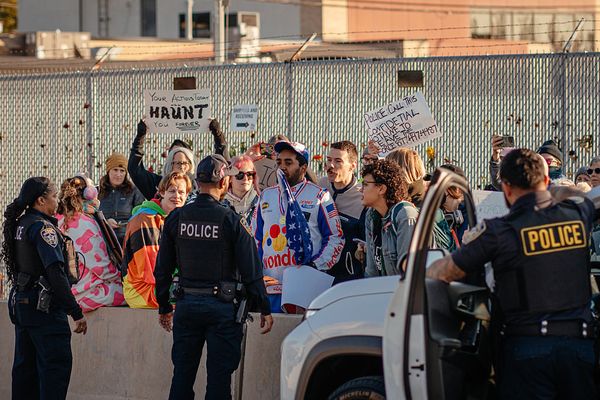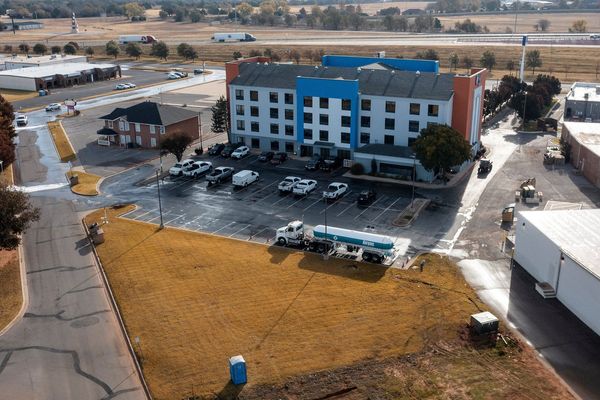
When Senate Democrats decided in September to use the government funding bill to put up a fight over expiring healthcare subsides, it set the stage for a 43-day federal government shutdown marked by turmoil for hundreds of thousands of federal workers, a battle over food benefits, thousands of cancelled flights, and a rare Democratic stand against Donald Trump’s second-term agenda that progressives had been demanding since the election.
Each week brought new disruptions and frustrations, until a group of seven moderate Democrats and one independent struck a deal to reopen the government in exchange for a promised – but not guaranteed – vote on the healthcare subsidies by mid-December.
Here are the critical moments from the shutdown’s first day to the final votes that ended the standoff.
Day 1
1 October
The government shutdown begins after midnight when the Senate rejected both the Republican‑led House stopgap funding bill, which would have kept the government funded through 21 November, and a Democratic alternative continuing resolution with healthcare subsidies.
The shutdown is the first one in six years, with the most recent being under Trump’s first term. Roughly 67,000 federal employees are furloughed, another 730,000 work without pay, 1.3 million active-duty troops and over 750,000 national guard and reserve personnel are also required to serve.
Day 2
2 October
The Department of Education says it would be furloughing approximately 95% of its staff. Some national parks and public lands close entirely, while others remain partly open.
Day 10
10 October
The Trump administration says it began issuing thousands of layoffs, according to a social media post from White House budget director, Russ Vought. The reductions come from agencies including the Environmental Protection Agency and Departments of Commerce, Education, Health and Human Services, Homeland Security, Housing and Urban Development and Treasury.
Day 14
14 October
US airports refuse to air a video by the Department of Homeland Security secretary, Kristi Noem, blaming Democrats for the shutdown.
Day 15
15 October
A federal judge blocks the Trump administration from laying off thousands of federal workers.
Day 16
16 October
The Senate votes on a funding bill fails for the 10th time.
Day 17
17 October
A key US nuclear agency said it will send 80% of its workforce home.
Day 18
18 October
An estimated 7 million people march against Trump across the country in coordinated No Kings Day protests.
Day 20
20 October
All federal courts lose funding and are forced to operate under the Antideficiency Act, which allows only work necessary for constitutional functions. Federal judges continued to serve, but court staff could only perform certain accepted activities without pay, while others were placed on furlough, causing criminal trial delays and mounting civil case backlogs.
Day 22
22 October
The shutdown becomes the second-longest in US history, surpassing the 21-day shutdown from 1995-96. Also, Jeff Merkley, a Democratic senator from Oregon, spoke for 22 hours and 37 minutes on the Senate floor in protest of what he called Trump’s authoritarianism.
Day 23
23 October
The US Senate fails to pass a bill to pay federal essential workers and troops through the shutdown.
Also, the 16,000-member Allied Pilots Association calls on Congress to end the shutdown right after the Southwest Airlines pilot union that represents 11,000 members does so. The Allied Pilots Association represents pilots, air traffic controllers and Transportation Security Administration agents without pay.
Day 24
24 October
Federal workers missed their first full paycheck during the government shutdown.
Day 27
27 October
Everett Kelley, leader of the top federal worker union, calls for an end to the US government shutdown.
Day 28
28 October
The Democratic attorney general or governor from 25 states together sue the Trump administration over the incoming Snap food benefits freeze during the shutdown.
Day 29
29 October
The Trump administration is blocked from suspending Snap benefits for millions of Americans. Also, the Congressional Budget Office estimates the shutdown has already caused $7bn in economic losses.
Day 30
30 October
Trump posted on Truth Social: “Get rid of the Filibuster, and get rid of it, NOW”. The Senate filibuster is a rule that allows the minority party of senators to delay or block a vote if the majority party doesn’t have a “supermajority”, or 60 seats in the Senate.
Currently, there are 53 Republican senators, 45 Democratic senators and two independent senators (who caucus with Democrats).
Day 31
31 October
The Trump administration reallocates an estimated $5.3bn in funds – $2.5bn from the “One Big Beautiful Bill Act”, $1.4bn from the Pentagon’s research and development account, and another $1.4bn from its procurement account – to pay active-duty troops.
Day 32
1 November
Snap benefits stop for 42-43 million Americans as the agriculture department ran out of funding for the first time in the program’s six-decade history. The Trump administration escalated the crisis when the USDA issued a memo ordering states to stop “unauthorized” Snap benefits, even as federal courts had ruled the withholding illegal.
Day 35
4 November
Democrats won across the board in Virginia’s house of delegates, state elected officials and governor’s race. They won the governor’s race in New Jersey, passed Proposition 50, a redistricting measure favorable to Democrats, in California, broke Mississippi’s supermajority, retained three justices in Pennsylvania’s supreme court to preserve the Democratic majority, and crossed more than 2 million voters in New York City’s mayoral election – the first time since 1969.
Also, the Senate failed to pass the funding package for the 14th time. Additionally, more than 16,700 flights had been delayed and 2,282 flights were canceled, according to FlightAware.
Day 36
5 November
The shutdown became the longest in US history, surpassing the 35-day Trump shutdown from 2018-19.
Also, at a breakfast with Senate and House Republicans in the White House, Trump blamed the GOP’s huge election losses nationwide on the government shutdown, saying it was a “big factor, negative”. He also reignited his demands to end the Senate filibuster.
Day 38
7 November
The Federal Aviation Administration announced it would reduce flights by up to 10% at 40 major airports across the country, which included Chicago O’Hare, Boston Logan, Atlanta’s Hartsfield-Jackson, Los Angeles International, Las Vegas Harry Reid International, all three New York-area airports, and dozens more.
Day 39
9 November
Seven Democrats and one independent sided with Republicans on a procedural vote, which is not final, to break the six-week logjam on the shutdown: senators Jeanne Shaheen and Maggie Hassan of New Hampshire, Angus King of Maine, Tim Kaine of Virginia, Catherine Cortez Masto and Jacky Rosen of Nevada, Dick Durbin of Illinois, and John Fetterman of Pennsylvania.
The deal was negotiated by Shaheen, Hassan and King, along with the Senate majority leader, John Thune, and the White House.
Day 40
10 November
The same coalition of lawmakers voted to approve the final bill to fund the federal government through 30 January 2026, sending it back to the House. It did not include a guaranteed extension of the Affordable Care Act marketplace tax credits, the long-held demand from the Democratic party, instead only promising a future vote on the matter.
Speaker Mike Johnson immediately ordered House members back to Washington, giving them 36 hours notice for a Wednesday vote despite widespread travel delays.
Also, angry Democrats call on Senate minority leader Chuck Schumer to resign after eight vote to end the shutdown.
Day 42
12 November
The House votes to pass the funding bill 222-209, with six Democrats breaking with their party to support it: Adam Gray of California, Tom Suozzi of New York, Marie Gluesenkamp Perez of Washington, Don Davis of North Carolina, Henry Cuellar of Texas and Jared Golden of Maine.
Two Republicans, Thomas Massie of Kentucky and Greg Steube of Florida, voted against it.







